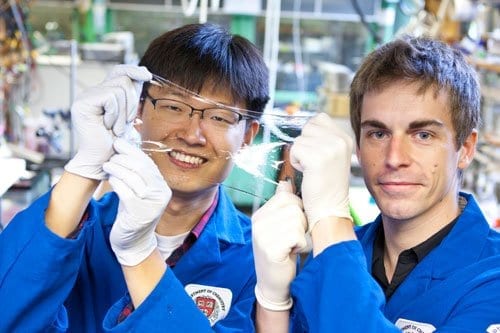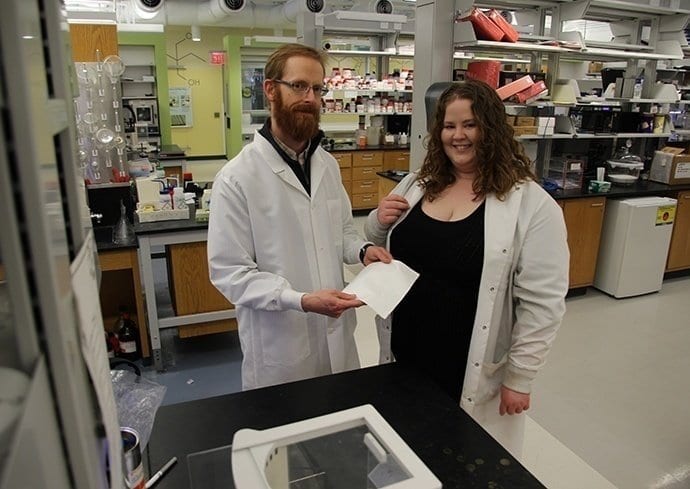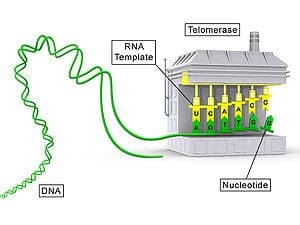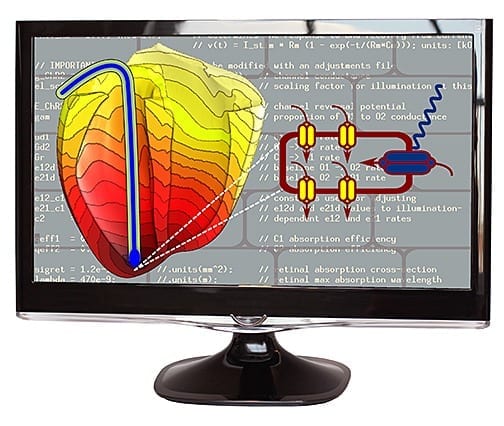
“The big vision is soft machines”
Gel-based audio speaker demonstrates capabilities of ionic conductors, long thought limited in application.
In a materials science laboratory at Harvard University, a transparent disk connected to a laptop fills the room with music—it’s the “Morning” prelude from Peer Gynt, played on an ionic speaker.
No ordinary speaker, it consists of a thin sheet of rubber sandwiched between two layers of a saltwater gel, and it’s as clear as a window. A high-voltage signal that runs across the surfaces and through the layers forces the rubber to rapidly contract and vibrate, producing sounds that span the entire audible spectrum, 20 hertz to 20 kilohertz (see video below).
But this is not an electronic device, nor has it ever been seen before. Published in the August 30 issue of Science, it represents the first demonstration that electrical charges carried by ions, rather than electrons, can be put to meaningful use in fast-moving, high-voltage devices.
“Ionic conductors could replace certain electronic systems; they even offer several advantages,” says co-lead author Jeong-Yun Sun, a postdoctoral fellow at the Harvard School of Engineering and Applied Sciences (SEAS).
For example, ionic conductors can be stretched to many times their normal area without an increase in resistivity—a problem common in stretchable electronic devices. Secondly, they can be transparent, making them well suited for optical applications. Thirdly, the gels used as electrolytes are biocompatible, so it would be relatively easy to incorporate ionic devices—such as artificial muscles or skin—into biological systems.
After all, signals carried by charged ions are the electricity of the human body, allowing neurons to share knowledge and spurring the heart to beat. Bioengineers would dearly love to mesh artificial organs and limbs with that system.
“The big vision is soft machines,” says co-lead author Christoph Keplinger, who worked on the project as a postdoctoral fellow at Harvard SEAS and in the Department of Chemistry and Chemical Biology. “Engineered ionic systems can achieve a lot of functions that our body has: they can sense, they can conduct a signal, and they can actuate movement. We’re really approaching the type of soft machine that biology has to offer.”
The audio speaker represents a robust proof of concept for ionic conductors because producing sounds across the entire audible spectrum requires both high voltage (to squeeze hard on the rubber layer) and high-speed actuation (to vibrate quickly)—two criteria which are important for applications but which would have ruled out the use of ionic conductors in the past.
The traditional constraints are well known: high voltages can set off electrochemical reactions in ionic materials, producing gases and burning up the materials. Ions are also much larger and heavier than electrons, so physically moving them through a circuit is typically slow. The system invented at Harvard overcomes both of these problems, opening up a vast number of potential applications including not just biomedical devices, but also fast-moving robotics and adaptive optics.
The Latest Bing News on:
Soft Machines
- Intuitive Machines Announces Date for First Quarter 2024 Financial Results Conference Callon May 1, 2024 at 1:16 pm
Inc. (Nasdaq: LUNR, LUNRW) (“Intuitive Machines”) (“Company”) announced today that it will release its financial results for the first quarter of 2024 on Tuesday, May 14, 2024, before the market opens ...
- Dunelm shoppers praise 'beautiful' washable rug for being 'thick' and 'soft' - on sale from £28on May 1, 2024 at 7:21 am
The Torres Global Washable Rug is now 20% off at Dunelm, with prices starting from £28 - £116, down from £35 - £145. The rug is available in four neutral colours and four sizes ...
- Dunelm's washable rug that is 'soft to walk on' slashed to £28 in bank holiday saleon May 1, 2024 at 1:59 am
The retailer has recently launched its Bank Holiday Savings Sale this week in preparation for the bank holiday weekend. Included is the Torres Global Washable Rug that is now 20 percent off, with ...
- Best washer dryers 2024: Two-in-one machines tried and testedon April 30, 2024 at 11:06 am
Water-churning appliances are by and large the most expensive machines in the home to run. In fact, the average washer/dryer used in the UK eats its insatiable way through 424kWh (that’s kilowatt ...
- NYC’s top restaurants dishing out fancy soft-serve ice cream as a cost-cutting dessert optionon April 30, 2024 at 9:56 am
I think having pastry departments is not as lucrative as it used to be in restaurants,” one executive chef told The Post. “There’s not many people that don’t like ...
- How to Catch More Fish Using Soft Plasticson April 29, 2024 at 1:44 pm
The latest generation of advanced soft plastics have spawned new tactics that allow anglers to target a variety of species in multiple locations.
- Billie Eilish makes bombshell tour announcement before Hit Me Hard and Soft dropon April 29, 2024 at 6:55 am
Hit Me Hard and Soft is Eilish's third studio album after When We All Fall Asleep, Where Do We Go? and Happier Than Ever. The album will be released on May 17. She first gained notoriety for her EP ...
- The Easiest and Best Way to Clean a Washing Machineon April 28, 2024 at 10:00 am
Now that the interior of the washer is nice and clean, it’s time to address the rest of the machine. Wipe down the smaller components, like the detergent and fabric softener dispensers, filters, and ...
- How the pretzel went from soft to hard – and other little-known facts about one of the world’s favorite snackson April 26, 2024 at 6:11 am
The pretzel, one of the fastest-growing snack foods in the world, recently crossed a billion dollars a year in sales. It has its own emoji, comes in flavors like pumpkin spice, mocha and banana, and ...
- Philly Gets Its First 24-Hour Cheese Vending Machineon April 23, 2024 at 11:43 am
Plus: A look at the new Mulherin’s Pizzeria, Black Hen opens on Chestnut Street, and the new coffee and plant shop in Rittenhouse.
The Latest Google Headlines on:
Soft Machines
[google_news title=”” keyword=”Soft Machines” num_posts=”10″ blurb_length=”0″ show_thumb=”left”]
The Latest Bing News on:
Ionic conductors
- Onsite PFAS Destruction: Understanding Electrochemical Oxidationon April 30, 2024 at 12:49 pm
As the need for PFAS treatment continues to emerge, landfills and waste management facilities can rely on electrochemical oxidation as a proven option for ...
- New sodium-ion battery tech boosts green energy storage affordabilityon April 30, 2024 at 10:10 am
In an advance for energy-storage technologies, researchers have developed high ionic-conductivity solid-state electrolytes for sodium-ion batteries that dramatically enhance performance at room ...
- Graphene at 20: why the ‘wonder material’ is finally coming goodon April 30, 2024 at 6:31 am
Strong, light and with amazing electronic properties, graphene has always been touted as the “wonder material”. But two decades after it was first isolated, James McKenzie believes the graphene is ...
- Unlocking New Potentials: Halting Light in Photonic Crystals Offers Photonic Device Innovationon April 29, 2024 at 12:03 am
Advanced technologies in photonic devices such as LED displays, fiber-optics, sensors, and lasers could see a significant leap forward thanks to innovative ways of manipulating light, including ...
- New Solid-State Electrolyte Increases the Affordability of Green Energy Storageon April 28, 2024 at 5:00 pm
These values are among the highest that have ever been found for sodium superionic conductors. In addition to its strong ionic conductivity, NYZS shows exceptional electrochemical stability and can ...
- Challenging Biologists’ Understanding: New Research Suggests Cells Possess Secret Communication Systemon April 26, 2024 at 5:45 pm
New study reveals that ion gradients across cell membranes create a network for swift cellular decision-making, separate from DNA. Cells constantly navigate a dynamic environment, facing ever-changing ...
- Study suggests that cells possess a hidden communication systemon April 24, 2024 at 11:41 am
Cells constantly navigate a dynamic environment, facing ever-changing conditions and challenges. But how do cells swiftly adapt to these environmental fluctuations?
- Cells may possess hidden communication systemon April 23, 2024 at 5:00 pm
Cells constantly navigate a dynamic environment, facing ever-changing conditions and challenges. But how do cells swiftly adapt to these environmental fluctuations? A new study is answering that ...
- SPDR Sees $16 Billion Outflow Exodus Year to Date; ETF League Tables as of April 19on April 19, 2024 at 2:04 pm
State Street has seen $16.4 billion in outflows this year, representing nearly 1% of the firm's assets under management according to etf.com data.
- Researchers Develop Revolutionary Cathode Material for Lithium-Sulfur Batterieson April 19, 2024 at 1:00 pm
Researchers at the University of California - San Diego have developed a self-healing cathode material that overcomes the challenges of traditional sulfur cathodes and could revolutionize solid-state ...
The Latest Google Headlines on:
Ionic conductors
[google_news title=”” keyword=”Ionic conductors” num_posts=”10″ blurb_length=”0″ show_thumb=”left”]










